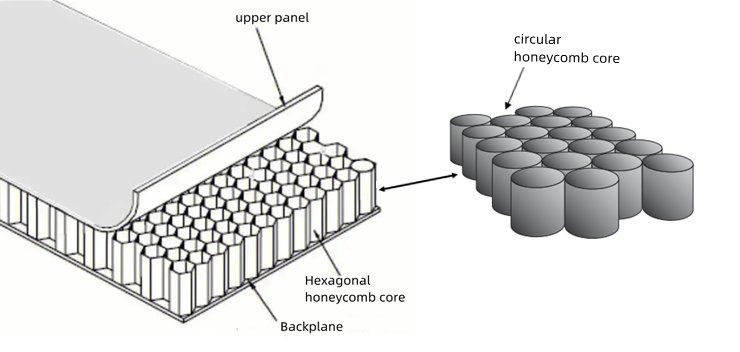How is low frequency reduced?
Effect of honeycomb core thickness on sound transmission loss
When gradually increasing the thickness of the core layer of honeycomb panels, the sound insulation capacity of honeycomb panels can be improved at a certain frequency. Because if increase the core layer thickness of the honeycomb board, can reasonably increase the bending stiffness of the honeycomb board, so also let in the sound transmission loss of stiffness control area, the core layer is thicker honeycomb board will have a better sound insulation ability, because the honeycomb board structure of their own unique frequency will be with the honeycomb board core layer thickness of the gradual increase of the increasing and constantly improve, so the frequency of the incident acoustic wave and the honeycomb board to reach the stage of the resonance of the intrinsic frequency also will be Correspondingly, the frequency of the incident sound wave and the honeycomb board's intrinsic frequency to reach the resonance stage will also move a little bit to the high frequency region. So in the high-frequency region, although the height of the core layer increases, the sound transmission loss is also gradually increasing.
So in the high frequency region, although the height of the core layer increases, the sound transmission loss increases gradually, but the thickness of the core layer does not have such a significant effect on the sound transmission loss, and it is almost in the same state. This is because, at high frequency, the most important factor to control the sound insulation performance has become the quality, due to the small density of the honeycomb core, so when increasing the core layer thickness, it will not have too much impact on the overall quality of honeycomb panels, so the impact of sound transmission loss is only a little bit, and it will not be as big as before.
Influence of different core structure on sound insulation
Dense rows of circular honeycomb sandwich panels have a greater impact on the sound transmission loss, which also has a better sound insulation performance, and then the sound transmission loss has a better ability to sparse rows of circular, and then triangular, and the worst sound insulation ability is the hexagonal and square, the hexagonal is slightly better than the square.

For the honeycomb paperboard structure, the sound insulation curve is first a clear downward trend, and then in a certain frequency near the bottom, the reason for this phenomenon is that this stage of the incoming sound frequency and honeycomb paperboard their own unique frequency is more and more close to the gradual resonance stage, which directly weakened the acoustic performance of honeycomb panel structure. However, as the frequency of the incoming sound wave continues to rise, it gradually reaches the stage where the sound insulation ability is mainly controlled by the stiffness and quality, and the sound insulation performance of honeycomb panels begins to gradually increase, but because the stiffness and quality of different core layer structures are also different, so the sound insulation performance will also have a certain impact.
Applicable fields
Automotive Industry: Plastic honeycombs can be used in vehicle components like headliners, door panels, and engine covers to reduce road and engine noise, enhancing the overall driving experience.
Building Construction: In architecture, plastic honeycomb materials can be integrated into wall panels, ceiling tiles, and partitions to mitigate airborne noise between rooms or from external sources.
Industrial Equipment: They can be applied to enclosures for noisy machinery to contain and reduce noise emissions, improving the working environment for operators.
HVAC Systems: In heating, ventilation, and air conditioning systems, plastic honeycomb structures can be used as sound-absorbing materials to reduce noise generated by fans and airflows.
Consumer Electronics: Plastic honeycomb materials can be integrated into speaker enclosures and headphones to improve sound quality and prevent sound leakage.
Aerospace Applications: In aircraft and spacecraft, plastic honeycombs can be utilized to reduce cabin noise and vibrations, enhancing the comfort of passengers and crew.
Marine Applications: In ships and boats, plastic honeycombs can help control noise levels, especially in engine rooms and cabins.
© 2018 Qingdao Achieving Honeycomb Panel Co., Ltd. All Rights Reserved. ![]() Powered by HiCheng
Email:info@cnhoneycomb.com
www.chinahoneycomb.com
Powered by HiCheng
Email:info@cnhoneycomb.com
www.chinahoneycomb.com

